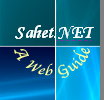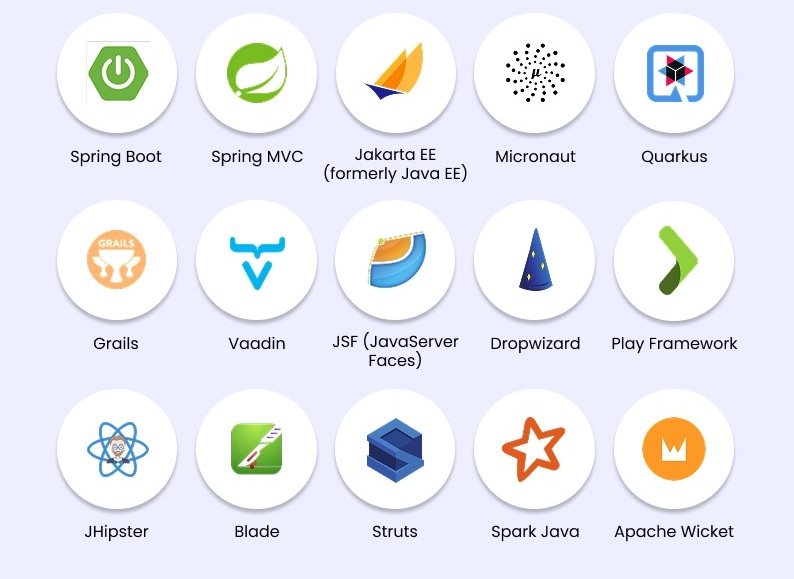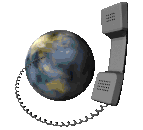
This page is consists of two main topics: Application
Frameworks and Integration
Frameworks.
 Application
Framework is a set of common software routines (e.g. Jakarta Project
creates and maintains open source software for the Java platform under the ASF) that provides
a foundation structure
for developing an application. Frameworks take the tedium out of writing all the program
code for an application from scratch.
Application
Framework is a set of common software routines (e.g. Jakarta Project
creates and maintains open source software for the Java platform under the ASF) that provides
a foundation structure
for developing an application. Frameworks take the tedium out of writing all the program
code for an application from scratch.
Object-oriented application frameworks are the norm today, are
structured as a class library.
Object Oriented
framework consists of a set of classes that work together to solve a family of
related problems.
Programmers can use inheritance and
delegation to extend the framework. Examples are RogueWave
Tools.h++, Model-View Controller (MVC), Microsoft Foundation Classes (MFC).
There are also frameworks geared to specific purposes (below table shows Specialized
Application Frameworks); for example, a framework for a content management
system (CMS) would include the infrastructure for developing Web e-commerce,
document maintenance and interactive user activities such as blogs and wikis (see Joomla!).
See also some modern web technologies, like: Angular, Node.Js,
React.js, Bootstrap, Gulp and
Grunt,
Python Frameworks, REST Django and other
web
technologies. See also:
Best Java
Frameworks,
Top 10 Development Frameworks
and list of below items.
|
Remark

Year by year new technologies (languages, frameworks and libraries, etc.) are evolving for software development. In such a rapidly evolving field, where technology is in a state of constant change, the ability to quickly learn and adopt a new technology effectively is a desirable skill for a technology expert. Technologies which are mentioned below are worth exploring. But choose the one which is still active or new and fulfills your needs. Some dormant or deprecated ones are mentioned only for a reference or for comparison.
Model View Controller
Model View
Controller (MVC) is
an architecture for building applications that separate the data (model) from the user interface (view) and the processing (controller). Providing a programming interface between the data
and the processing has been a primary concept in information technology for decades. MVC is
widely used in Web-based application frameworks.
In practice, MVC views and controllers are often combined into a single object because they
are closely related. For example, the
controller code validates a request for data and causes it to be returned in a view.
View-controller objects are tied to only one model; however, a model can have many
view-controller objects associated with it.
Implementations of MVC as Web-based Frameworks
Web application frameworks (e.g. Struts, Spring MVC are examples of Implementaion of MVC) are software tools that are commonly used to aid in the creation and management of various types of online applications. A web application framework can involve designing and launching pages for a website or provisioning various applications to provide a wide range of web services to consumers. The framework tends to include all the elements needed to accomplish the desired tasks, thus eliminating the need to secure the necessary tools from different sources.. There are numerous JAVA FRAMEWORKS either in development or in use. Many of these frameworks are built on top of, or borrow elements from the Java EE platform or Eclipse etc.
|
|
Comparision of web frameworks: list of other java web frameworks, Comparing, Struts1 and Struts2, Comparison wiki, Comparison 1, Comparison 2.
Spring and EJB Framework ⇧
In an enterprise application, business logic forms the basis of transforming the persisted data. That is the reason why the business logic layer is considered the most important layer of any enterprise application. Typically, the Java Enterprise Edition (JEE) component that was used to implement business logic was Enterprise Java Beans (EJB). However, EJBs are heavy weight components that require application servers to run. XDoclet - Attribute-Oriented Programming: XDoclet - About
This EJB was the scenario before the Spring Framework came into the picture. The Spring Framework provides a lightweight container to run the objects implementing business logic. In other words, Spring Framework-based business objects do not require an application server to run. Spring Framework is "An open-source layered Java/J2EE application framework having a light-weight container implementing Inversion-of-Control and Aspect Oriented Programming." The key points here are "layered application framework" and "Inversion of Control and Aspect Oriented Programming." See also Continuous integration ( CI ).
Spring Boot and Microservices⇧
Spring Boot 4 & Spring Framework 7: What's New?, SpringBoot 4 GA, Spring 7 GA
Spring also owns some disadvantages (see pros-and-cons) like increased project size due to dependencies and its management, complex configuration and debugging. Spring Boot helps developers build applications with ease and with far less toil than other competing paradigms. Embedded web servers, auto-configuration, and “fat jars” help you get started quickly, and innovations like LiveReload in Spring DevTools mean developers can iterate faster than ever before.
Microservice architectures are the ‘new normal’. Building small, self-contained, ready to run applications can bring great flexibility and added resilience to your code. Microservice architecture is not complete without Spring Cloud ‒ easing administration and boosting your fault-tolerance. Developing distributed systems can be challenging, but Spring Cloud provides tools to quickly build some of the common patterns in distributed systems (e.g. configuration management, service discovery, circuit breakers, intelligent routing, micro-proxy, controlbus).
See other frameworks for developing Microservices: Quarkus, Micronaut, Eclipse Vert.x., Ballerina
|
Web Service Frameworks in Java ⇧
What is a Web Service?, What is a
REST?
A Web service (Java EE Web service)
is a method of communication between two electronic devices over World Wide Web. A web
service is a software function provided at a network address over the web or the cloud; it
is a service that is "always on" as in the concept of utility computing.
More about Web Services:
webservicex.net,
Specification,
WML ,
WML Script,
RSS,
Tutor
ial,
Apache WS,
Java Web Services
REST
(REpresentational State Transfer)
is an architectural style, and an approach to communications that is often used in the
development of Web services. The use of REST is often preferred over the more heavyweight
SOAP (Simple Object Access Protocol) style because REST does not leverage as much bandwidth,
which makes it a better fit for use over the Internet.
Building
RESTful Web Services with JAX-RS,
RESTful
Web Services
See also: • Java Web Services • XML Usage in Web Applications • XML Processing (JAXP) and JAXB • Web Toolkit • RESTful Micro Frameworks, • Microservices with Spring, • REST services and microservices
|
|
Comparision Web service frameworks: List of WS, Open Source Web Services Tools in Java, Web services, Framework comparisions, Comparison
Persistence Frameworks in Java
Java persistence evolved from rudimentary JDBC and the complex EJB 2 entity beans to the standardized Java Persistence API (JPA) in 2006, which drew from the open-source Hibernate framework. Following this, JPA was renamed Jakarta Persistence in 2019 after the Java EE project moved to the Eclipse Foundation, continuing its evolution with versions like Jakarta Persistence 3.1 and 3.2 under the new namespace jakarta.persistence. See list of Java Persistence Frameworks
Modern Trends:
Spring Data (since
2011): Introduced higher-level abstractions for repository-based access,
simplifying development. Year by year evolving to keep adding new improvements.
Jakarta Data: Evolving from Java EE, it further simplifies data access.
Challenges: Despite advancements, challenges remain, including performance overhead
from
data conversions and the complexity of managing object graphs and schema migrations
|
|
See also • SQL Tutorial • Database Management Systems (DBMS) • Object Relational (OR) Mapping
Java Presentation Frameworks ⇧
|
|
Reporting and Business Intelligence Frameworks in Java.
|
|
Comparision reporting frameworks: Charting and Reporting Tools, More Tutorials, DocFlex, PDF and Postscript
Intelligent Agent Framework
There is growing interest in using intelligent software agents for a variety of tasks, including navigating and retrieving information from the Internet and from databases, online shopping activities, user authentication, negotiation for resources, and decision making, see also Artificial Intelligence.
- Java Agent - JADE, is a software framework for multi-agent
systems.
See more: Jade Agent Frameworks, Agent App. with Java, JACK Intelligent Agents, Intelligent Agents
Testing Frameworks in Java ⇧
|
|
More Testing tools: Test Automation, 2, Top 10, Testing Tools in Java, Testing, JWebUnit, SELENIUM, Compare1, Test Framework Comparison, Testing FAQ, Unitils
Java Logging Frameworks
|
|
Comparision of logging frameworks: Logging Tools and Frameworks, Other platforms, Logging Dependencies in Spring
Java Security Frameworks in Java ⇧
-
The Basics of Java
Security,
- Java Security Overview - Enterprise Security API Toolkits help software developers guard against security-related design and implementation flaws. More details. OWASP Enterprise Security API also VeriSIGN
- JAAS Access Control, Spring Security [new] ( see samples, sprinboot-security-autoconfiguration ) is a Java/Java EE framework that provides advanced authentication, authorization and other security features for enterprise applications. Spring Acegi Security (old) Security is a powerful, flexible security solution for enterprise software, with a particular emphasis on applications that use Spring. jGuard is written in Java. Its goal is to provide a security framework based on JAAS (Java Authentication and Authorization Security). See more: Journal, JAAS Tutorial
- Encryption -
refers to algorithmic schemes that encode plain text into non-readable form or
cyphertext, providing privacy.
Bouncycastle - Lightweight
Java cryptography APIs.
Jasypt is a java library which
allows the developer to add basic encryption capabilities.
See more: Java Cryptography Architecture, SUN Tutorial
See also: Java Security Technology and Computer Security and Cryptography, Java MD5 Hashing, Other Security Tools
Rule Engines and Workflow Engines in Java
A workflow engine
(e.g. jBPM, iProcess, etc.) is a software application that manages and executes modeled
computer processes. A workflow approach to analyzing and managing a business process can be combined with an
object-oriented programming approach, which tends to focus on documents and data.
A business rules engine
(e.g. Drools, etc., more about BRE) is a software system that executes one or more business rules
in a runtime production environment.
- jBPM (old name was: Drools
Flow) - is a flexible Business Process Management (BPM) Suite. It makes the bridge
between business analysts and developers.
See more: wiki, User Guide, jBPM 5 tutorial - first example - iProcess - TIBCO iProcess Suite offers a one of a kind and
powerful business processes management tool to help your company achieve this aim. Tibco
iProcess engine will be deferred, currently it belongs to TIBCO
Framework.
See more: Quick introduction to TIBCO iProcess components, Getting Started - XWorkflow -
is a an
engine extended with Spring that allows you to define workflows in xml. See also: Spring Integration.
without XWorkflow: Simple Workflow Engine With Spring, Spring Webflow - Drools - is a
business rule management system (BRMS) with a forward chaining inference based rules
engine, more correctly known as a production rule system, using an enhanced
implementation of the Rete algorithm.
See more: Drools Introduction, Why use a Rule Engine?, JBoss Drools Tutorial
List of other Engines: Top 10 java-workflow-engine, Open Source Workflow Engines in Java and Open Source Rule Engines in Java
Build Systems, POM, and Source Control (see also: DevOps, Project Health Tools)
More on: • Open Source Build Systems in Java • Source Control Tools in Java, • Software Management • Project Health Tools
- Ant -
is a software tool for automating software build processes. It uses XML to describe the
build process and its dependencies.
See more: About, Ant - Usage, Tutorialspoint, Tutorial - Maven -
is a Java project management and project comprehension tool. Maven is based on the
concept of a project object model (POM).
See more: About, Skinny WARs, Tutorialspoint, vimp, in Eclipse , Maven Overlays, 3, excl-ear, Bill of Materials use BOM (svn -list -R -v), maven-bom, 2, Spring Maven BOM - Gradle - is a build automation tool for multi-language software development. It manages tasks like compilation, packaging, testing, deployment, and publishing. Supported languages include Java (as well as JDK-based languages Kotlin, Groovy, Scala), C/C++, and JavaScript. Home, Tutorial, Gradle Plugin, spring boot+gradle
- Ivy - is a free java based dependency manager, with powerful features such as transitive dependencies, ant integration, maven repository compatibility, continuous integration, html reports and many more See more: About, Tutorial
- Version control software, sometimes called SCM (Source Code Management), helps you manage a software project. It provides a common repository that stores the code to be shared and more. See: Git - is a free and open source distributed(de-centralized) version control system designed to handle everything from small to very large projects with speed and efficiency. Use it with online services like GitHub, GitLab, or Bitbucket to share your work with others. These are called remote repositories. CVS, Mercurial, Subversion Clearcase - is a free java based dependency manager, with powerful features such as transitive dependencies, ant integration, maven repository compatibility, continuous integration, html reports and many more See more: Source Control Tools in Java, Compare
Suggested Reading: Software configuration management, Build Tools in Java Development, ViewVC, Compare build tools
Java Media Frameworks ⇧
|
|
See also: • Java ME • Java 3D • Graphic Objects (2D & 3D)
XML & JSON Frameworks in Java ( Open Source XML Parsers, XML UI)
Standards you need to be familiar as a priority, see XML & JSON Topics, XML Usage in Web Applications • XML Processing (JAXP) and JAXB • X-Stream Annotations
|
Comparision of xml tools: Comparing Data Binding Tools • Java XML Tools, • JSON library comparison Tools, • Gson vs Jackson
Integration Frameworks ⇧

Software architecture and software design are two aspects of the same topic.
Enterprise
integration is a technical field of Enterprise Architecture, which focused
on the study of topics such as system interconnection, electronic data interchange, product
data exchange and distributed computing environments.
Enterprise Information Integration (EII), is the ability to support
a unified view of data and information for an entire organization.
ARIS
(Architecture of Integrated Information Systems) is an approach to enterprise modeling. See
also: BUSINESS PROCESS
MODELING TOOLS
Java Business Integration (JBI)
is a specification developed under the Java Community Process (JCP) for an approach to
implementing a service-oriented architecture (SOA). The following open-source software JBI based ESB implementations are available here and an example.
The Application Integration Framework (AIF) enables companies to integrate and communicate with other
business processes and partners electronically. E.g. Overview of AIF is the infrastructure
within Microsoft Dynamics AX with which you can expose business logic or exchange data with
other systems. E.g.
Microsoft Dynamics AX, Trask
Application Integration.
An Enterprise Architecture Framework
(EA
framework) defines how to create and use an enterprise architecture.
Enterprise Application Integration - EAI (see implementations: EAI Commercial products, e.g. TIBCO Business
Works, EAI using J2EE) is the use of software and computer
systems architectural principles to integrate a set of enterprise computer applications,
e.g.
Patterns
and Best Practices for EI,
2
What is a TIBCO BW (Business Works)?
TIBCO ActiveMatrix BW is one of the leading service creation, orchestration, and integration products on the market. It has been deployed by over thousands companies worldwide and is the foundation for several of the largest mission critical service-oriented business applications in production today. For ore information: TIBCO ActiveMatrix BusinessWorks Essentials.
Other Tools: Java Toolkit • API's • Programmer's Corner • WebDev. Tools • Database Tools • Modeling & Design • Multimedia (AI Tools) • Maths and Science
Some other practical Java Frameworks
References
- Comparison of web application frameworks
- Open Source Web Frameworks
- Integration using J2EE
- EAI
- Choose language to compare web frameworks